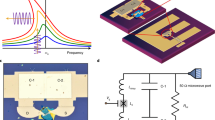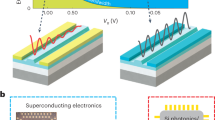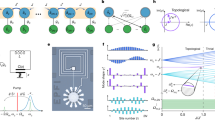Abstract
With a large portfolio of elemental quantum components, superconducting quantum circuits have contributed to advances in microwave quantum optics1. Of these elements, quantum-limited parametric amplifiers2,3,4 are essential for low noise readout of quantum systems whose energy range is intrinsically low (tens of μeV)5,6. They are also used to generate non-classical states of light that can be a resource for quantum enhanced detection7. Superconducting parametric amplifiers, such as quantum bits, typically use a Josephson junction as a source of magnetically tunable and dissipation-free non-linearity. In recent years, efforts have been made to introduce semiconductor weak links as electrically tunable non-linear elements, with demonstrations of microwave resonators and quantum bits using semiconductor nanowires8,9, a two-dimensional electron gas10, carbon nanotubes11 and graphene12,13. However, given the challenge of balancing non-linearity, dissipation, participation and energy scale, parametric amplifiers have not yet been implemented with a semiconductor weak link. Here, we demonstrate a parametric amplifier leveraging a graphene Josephson junction and show that its working frequency is widely tunable with a gate voltage. We report gain exceeding 20 dB and noise performance close to the standard quantum limit. Our results expand the toolset for electrically tunable superconducting quantum circuits. They also offer opportunities for the development of quantum technologies such as quantum computing, quantum sensing and for fundamental science14.
This is a preview of subscription content, access via your institution
Access options
Access Nature and 54 other Nature Portfolio journals
Get Nature+, our best-value online-access subscription
$29.99 / 30 days
cancel any time
Subscribe to this journal
Receive 12 print issues and online access
$259.00 per year
only $21.58 per issue
Buy this article
- Purchase on Springer Link
- Instant access to full article PDF
Prices may be subject to local taxes which are calculated during checkout




Similar content being viewed by others
Data availability
The data that support the findings of this study are available in Zenodo with the identifier https://doi.org/10.5281/zenodo.7025633.
References
Schoelkopf, R. J. & Girvin, S. M. Wiring up quantum systems. Nature 451, 664 (2008).
Castellanos-Beltran, M. A. & Lehnert, K. W. Widely tunable parametric amplifier based on a superconducting quantum interference device array resonator. Appl. Phys. Lett. 91, 083509 (2007).
Castellanos-Beltran, M. A., Irwin, K. D., Hilton, G. C., Vale, L. R. & Lehnert, K. W. Amplification and squeezing of quantum noise with a tunable Josephson metamaterial. Nature Phys. 4, 929 (2008).
Vijay, R., Slichter, D. H. & Siddiqi, I. Observation of quantum jumps in a superconducting artificial atom. Phys. Rev. Lett. 106, 110502 (2011).
Teufel, J. D., Donner, T., Castellanos-Beltran, M. A., Harlow, J. W. & Lehnert, K. W. Nanomechanical motion measured with an imprecision below that at the standard quantum limit. Nature Nanotech. 4, 820 (2009).
Walter, T. et al. Rapid high-fidelity single-shot dispersive readout of superconducting qubits. Phys. Rev. Appl. 7, 054020 (2017).
Backes, K. M. et al. A quantum enhanced search for dark matter axions. Nature 590, 238 (2021).
de Lange, G. et al. Realization of microwave quantum circuits using hybrid superconducting-semiconducting nanowire Josephson elements. Phys. Rev. Lett. 115, 127002 (2015).
Larsen, T. W. et al. Semiconductor-nanowire-based superconducting qubit. Phys. Rev. Lett. 115, 127001 (2015).
Casparis, L. et al. Superconducting gatemon qubit based on a proximitized two-dimensional electron gas. Nature Nanotech. 13, 915 (2018).
Mergenthaler, M. et al. Circuit quantum electrodynamics with carbon-nanotube-based superconducting quantum circuits. Phys. Rev. Appl. 15, 064050 (2021).
Schmidt, F. E., Jenkins, M. D., Watanabe, K., Taniguchi, T. & Steele, G. A. A ballistic graphene superconducting microwave circuit. Nature Commun. 9, 4069 (2018).
Wang, J. I. et al. Coherent control of a hybrid superconducting circuit made with graphene-based van der Waals heterostructures. Nature Nanotech. 14, 120 (2019).
Sikivie, P. Invisible axion search methods. Rev. Mod. Phys. 93, 015004 (2021).
Zimmer, H. Parametric amplification of microwaves in superconducting josephson tunnel junctions. Appl. Phys. Lett. 10, 193 (1967).
Park, J. et al. Short ballistic Josephson coupling in planar graphene junctions with inhomogeneous carrier doping. Phys. Rev. Lett. 120, 077701 (2018).
Nanda, G. et al. Current-phase relation of ballistic graphene josephson junctions. Nano Lett. 17, 3396 (2017).
Schmidt, F. E., Jenkins, M. D., Watanabe, K., Taniguchi, T. & Steele, G. A. Probing the current-phase relation of graphene Josephson junctions using microwave measurements. Preprint at https://arxiv.org/abs/2007.09795 (2020).
Haller, R. et al. Phase-dependent microwave response of a graphene Josephson junction. Phys. Rev. Research 4, 013198 (2022) https://doi.org/10.1103/PhysRevResearch.4.013198
Yurke, B. & Buks, E. Performance of cavity-parametric amplifiers, employing Kerr nonlinearites, in the presence of two-photon loss. J. Lightw. Techn. 24, 5054 (2006).
Mutus, J. Y. et al. Design and characterization of a lumped element single-ended superconducting microwave parametric amplifier with on-chip flux bias line. Appl. Phys. Lett. 103, 122602 (2013).
Planat, L. et al. Understanding the saturation power of Josephson parametric amplifiers made from SQUID arrays. Phys. Rev. Appl. 11, 034014 (2019).
Eichler, C. & Wallraff, A. Controlling the dynamic range of a Josephson parametric amplifier. EPJ Quant. Techn. 1, 2 (2014).
Macklin, C. et al. A near quantum-limited Josephson traveling-wave parametric amplifier. Science 350, 307 (2015).
Yamamoto, T. et al. Flux-driven Josephson parametric amplifier. Appl. Phys. Lett. 93, 042510 (2008).
Vissers, M. R. et al. Low-noise kinetic inductance traveling-wave amplifier using three-wave mixing. Appl. Phys. Lett. 108, 012601 (2016).
Larsen, T. W. et al. Parity-protected superconductor-semiconductor qubit. Phys. Rev. Lett. 125, 056801 (2020).
Lee, G.-H. et al. Graphene-based Josephson junction microwave bolometer. Nature 586, 42 (2020).
Kokkoniemi, R. et al. Bolometer operating at the threshold for circuit quantum electrodynamics. Nature 586, 47 (2020).
Antony, A. et al. Miniaturizing transmon qubits using van der Waals materials. Nano Letters 21, 10122 (2021).
Wang, J. I. et al. Hexagonal boron nitride as a low-loss dielectric for superconducting quantum circuits and qubits. Nat. Materials 21, 398 (2022).
Sarkar, J. et al. Quantum noise limited microwave amplification using a graphene josephson junction. Preprint at https://arxiv.org/abs/2204.02103 (2022).
Wang, L. et al. One-dimensional electrical contact to a two-dimensional material. Science 342, 614 (2013).
Acknowledgements
We thank J. Aumentado and F. Lecocq (National Institute of Standards and Technology, Boulder, CO, USA) for providing the SNTJ and for discussions. This work was supported by the French National Research Agency (ANR) in the framework of the Graphmon project (grant no. ANR-19-CE47-0007). K.W. and T.T. acknowledge support from JSPS KAKENHI (grant nos. 19H05790, 20H00354 and 21H05233). J.R. acknowledges E. Eyraud and W. Wernsdorfer for help with the cryogenic system. We acknowledge the work of J. Jarreau, L. Del-Rey and D. Dufeu for the design and fabrication of the sample holders and other mechanical pieces used in the cryogenic system. We thank the Nanofab group at Institut Néel for help with device fabrication. We thank K.W. Murch and B. Sacépé for discussions and comments on the manuscript.
Author information
Authors and Affiliations
Contributions
K.W. and T.T. grew the h-BN crystals. G.B. and J.R. designed the samples. G.B. and N.A. fabricated the devices. G. B., A.J. and J.R. performed d.c. measurements. G.B. performed the microwave measurements with help from K.R.A. and J.R. Noise measurements were realized by G.B., A.R. and M.E. with help from N.R. and J.R. Data analysis was performed by G.B. with help from A.R., N.R. and J.R. The project was supervised by F.L. and J.R. G.B. prepared the figures of the manuscript. J.R. wrote the manuscript with input from all authors.
Corresponding author
Ethics declarations
Competing interests
N.R. is founder and shareholder of Silent Waves.
Peer review
Peer review information
Nature Nanotechnology thanks Kin Chung Fong, Zhuoqun Hao and the other, anonymous, reviewer(s) for their contribution to the peer review of this work.
Additional information
Publisher’s note Springer Nature remains neutral with regard to jurisdictional claims in published maps and institutional affiliations.
Extended data
Extended Data Fig. 1 Design of the device.
a) Schematic of the device (to scale). A resonator (purple) is capacitively coupled to a transmission line (red) as shown in the left inset. A side gate (green) is used to tune the graphene Josephson junction (gJJ) (located in the center of the resonator) critical current. The right inset shows an optical picture of the gJJ. Additional lines (blue) are connected close to the center of the resonator to perform d.c. measurements on the gJJ. They are located 20 μm away from the junction. Lines between the pads and the thick lines are bonding wires. (b) Phase of S11 measured and fitted for a bare device where the gJJ is replaced by a short between the two parts of the resonator.
Extended Data Fig. 2 Graphene Josephson junction d.c. properties.
(a) Differential conductance with respect to the bias voltage. The dark line indicates the position of the first multiple Andreev reflection (MAR) peak at a voltage value of 2Δ/e. (b) Differential resistance as a function of the gate voltage measured at 25 mK with a bias current of 7μA. (c) eRnIc/Δ product with respect to the gate voltage.
Extended Data Fig. 3 Experimental setups.
Noise measurement setup (a) and d.c. measurement setup (b). Both the setups use a dilution fridge and allow for standard microwave measurements.
Extended Data Fig. 4 Added noise of the graphene Josephson parametric amplifier.
(a) and (b) extracted added noise with respect to the frequency. The blue curve represents the extracted added noise from the graphene Josephson parametric amplifier (gJPA) measurement. The purple curve represents the added noise extracted by the printed circuit board (PCB) measurement, that is, the chain noise without the JPA. The red curve represents the added noise computed from the added noise extracted by the PCB measurement and the measured gain of the gJPA in the limit where the JPA does not add noise, that is, the expected noise at the standard quantum limit (SQL).
Supplementary information
Supplementary Information
Supplementary Figs. 1–11 and Discussion (Sections 1–6).
Rights and permissions
Springer Nature or its licensor holds exclusive rights to this article under a publishing agreement with the author(s) or other rightsholder(s); author self-archiving of the accepted manuscript version of this article is solely governed by the terms of such publishing agreement and applicable law.
About this article
Cite this article
Butseraen, G., Ranadive, A., Aparicio, N. et al. A gate-tunable graphene Josephson parametric amplifier. Nat. Nanotechnol. 17, 1153–1158 (2022). https://doi.org/10.1038/s41565-022-01235-9
Received:
Accepted:
Published:
Issue Date:
DOI: https://doi.org/10.1038/s41565-022-01235-9
This article is cited by
-
Quantum-noise-limited microwave amplification using a graphene Josephson junction
Nature Nanotechnology (2022)
-
Graphene amplifier reaches the quantum limit
Nature Nanotechnology (2022)



